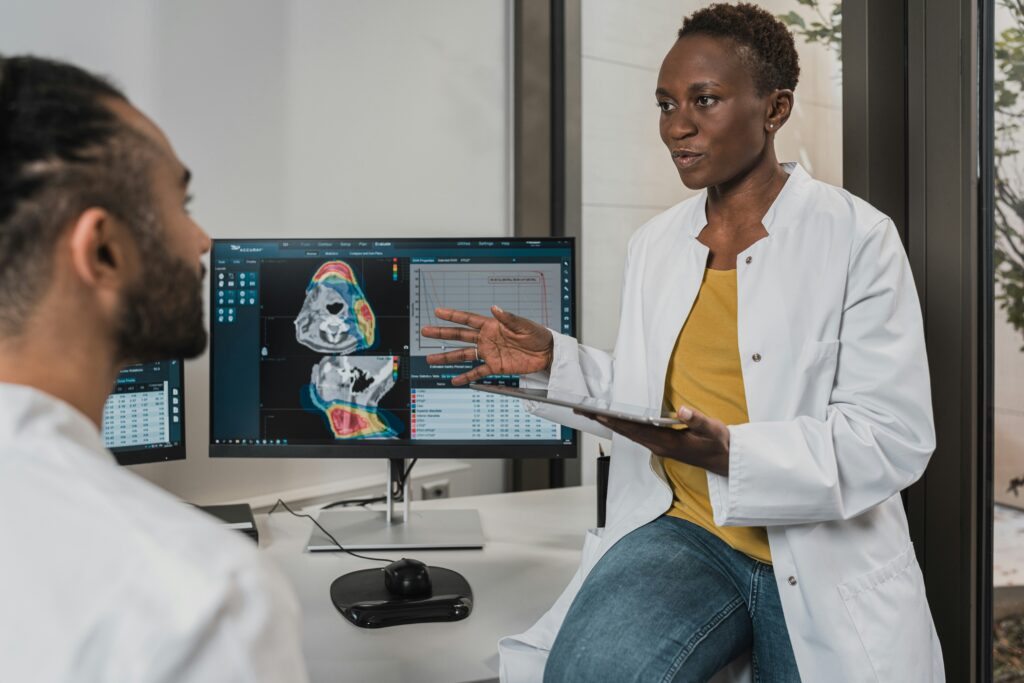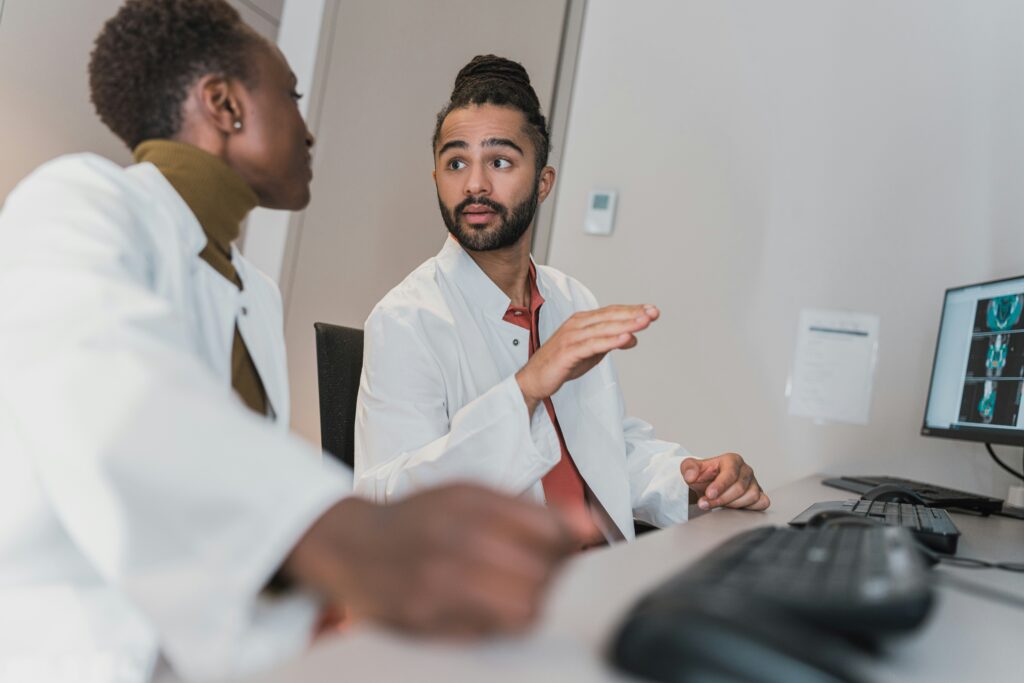Updated: 1 September, 2025
Introduction
Organizations and educational institutions increasingly rely on peer feedback to foster deeper learning, reflective practice, and performance improvement. In clinical education, where soft skills like communication, empathy, and decision-making are essential, peer feedback provides a structured and scalable method for personal development. This article explores why feedback matters, introduces key feedback models, and outlines how to effectively implement peer feedback in healthcare settings.
What Is Peer Feedback in Clinical Training?
Peer feedback is the process by which students or professionals assess each other’s performance using structured observations and criteria. In healthcare education, it supports the development of clinical reasoning, communication, and collaborative skills. Unlike coaching or instructor-led evaluations, peer feedback often takes place among equals, fostering openness and mutual learning.
Why Peer Feedback Matters in Medical Education
Modern medical education increasingly emphasizes teamwork and interprofessional collaboration. In this context, traditional top-down feedback methods are often insufficient. Peer feedback provides a continuous, low-stakes feedback loop that supports reflection, learning, and performance improvement.
It helps:
- Strengthen learner motivation and accountability
- Offer diverse perspectives beyond faculty input
- Build essential soft skills like empathy and communication
- Reinforce self-evaluation habits through regular engagement
As trainers have less direct visibility into everyday trainee interactions, structured peer input has become a reliable source of meaningful, timely feedback. It reduces performance anxiety, encourages mutual learning, and promotes the internalization of performance standards.
Research suggests that peer feedback contributes to skill development by:
- Clarifying goals and expectations
- Encouraging constructive dialogue
- Boosting confidence and self-awareness
The University of Oxford’s Centre for Teaching and Learning highlights the importance of allowing students to explore evaluation criteria themselves. This fosters deeper understanding and strengthens their ability to assess peers effectively.
For peer feedback to be successful, three elements are key:
- Clear rubrics that outline expectations
- Opportunities to practice giving feedback
- Timely examples that model constructive critique
When well-integrated, peer feedback not only improves performance but also supports the culture of reflection and continuous development needed in clinical education.

Feedback Models Used in Healthcare Training
Feedback models are structured approaches used to provide constructive feedback in various settings, including education, healthcare and professional environments. They offer clear frameworks for delivering feedback effectively, ensuring clarity and promoting self-reflection and improvement. Some popular feedback models are:
Situation-Behaviour-Impact (SBI) Model
Developed by the Center for Creative Leadership, it focuses on three key elements (situation, behavior, impact). The person providing the feedback starts by describing the specific context where the behavior occurred and then outlines the observed actions done in that setting. Lastly, they explain the effect of the behavior on themselves, the team and/or the organization. This model focuses on observed facts rather than assumptions or judgements. It is particularly useful for both positive and constructive feedback, helping recipients understand the context and consequences of their actions.
360-Degree Feedback
The 360-degree feedback model involves collecting input from multiple sources, including supervisors, peers, subordinates and sometimes even clients or customers.
The process typically includes self-assessment by the employee; feedback collection from various supervisors; analysis and compilation of feedback; sharing results with the person being evaluated; and creating a development plan based on the feedback. This comprehensive approach provides a well-rounded view of an individual’s performance, offering insight that might not be apparent from a single perspective. It is valuable for leadership development and identifying blind spots in an individual’s performance.
BOOST Feedback Model
The acronym ‘BOOST’ stands for Balanced, Observed, Objective, Specific, Timely. It centers around providing both positive and constructive feedback (balanced) based on directly observed behaviors (observed), and focusing on facts and outcomes instead of opinions (objective) through detailed examples (specific). This model emphasizes the importance of delivering balanced, fact-based feedback as soon as possible after the observed behavior (timely) so as to ensure the feedback is relevant and fresh in the recipient’s mind.
Team-based learning (TBL)
Team-based learning is a structured small-group approach that stresses preparation outside the classroom and in-class application. It is favored in healthcare for its collaborative nature, similar to hospital settings, and for evaluating theoretical and practical activities like clinical problem-solving. This feedback model consists of several key components:
- A readiness assurance process (RAP) in which individual students (iRAP) and teams (tRAP) complete a test before the activity to assess their preparation, promoting discussion and peer teaching.
- An immediate feedback session in which teams receive feedback on their tRAP answers from facilitators or trainers, identify knowledge gaps and clarify concepts through follow-up questions.
- A team activities session involves teams working on specific tasks. They discuss various strategies and choices. Teams report their decisions at the same time. This structure encourages teams to articulate their thoughts. It also helps them evaluate their reasoning when faced with different decisions from other teams.
- A peer evaluation in which students evaluate their teammates’ contributions to team activities, providing both quantitative and qualitative feedback.
How do we integrate peer feedback?
Integrating feedback effectively is crucial for personal and professional development. The concept of integration relates to the Organismic Integration Theory (OIT), which focuses on the process of internalizing external motivations and regulations. It proposes a continuum of motivation ranging from amotivation to intrinsic motivation, with various forms of extrinsic motivation in between.
The OIT suggests two key components for feedback integration: internalization and integration. Internalization involves turning external rules into personal motivations. Integration is the most autonomous form of extrinsic motivation, where external rules become part of one’s self.When receiving feedback, the aim is to integrate it into your values and goals. This process is supported by fulfilling the three basic psychological needs from Self Determination Theory (SDT): autonomy, competence, and relatedness. You can read more about the Self Determination Theory here.
Things to consider when providing feedback to peers
A recent study conducted by Oakland University William Beaumont School of Medicine (OUWB) used the TBL peer evaluation system to assist a group of medical students (ranging from year 1 to year 4 of their program) in providing feedback on peers’ cooperative learning skills multiple times throughout their preclinical years. The author and his team observed several recurring themes amongst participants:
- Be prepared. The importance of preparation and instruction on how to provide and receive feedback, particularly how beneficial it would have been during the first two years of their medical program. The students recognized the value in developing these soft skills early on in their formative years as they felt it was translatable from a classroom setting to a clinical setting later.
- Be flexible. Some participants felt that feedback models were too rigid, hindering honest expression. Others found the lack of objective benchmarks made evaluations seem unfair and inconsistent.
- Keep the conversation going. Interestingly, students preferred to discuss feedback and the roadmap to its implementation via face-to-face instead of through an online survey. They found it easier to empathize and expand on the issues presented in the evaluation without altering the relationship with the other party.
- Allow time for self reflection. Direct quotes from students in the study suggested that going into a peer review after self-reflection helped make the assessment a more collaborative experience. Dive deeper on self reflection on our blog exploring its importance during healthcare training.
- Be mindful. Two frequently mentioned barriers when providing peer feedback was the difficulty in identifying areas for improvement due to inexperience in peer assessment and the fear of offending their colleagues or causing other peers or faculty to view certain students unfavorably.

What to avoid when giving feedback?
“For peer feedback to succeed, there needs to be an institutional environment that encourages trust between peers and teachers and is also perceived as being a safe space where such feedback is seen as constructive and in the best interests of all parties” – Lerchenfeldt et al. (2023)
Establishing a safe feedback platform is crucial for open communication and continuous improvement. It enhances self-reflection and fosters a culture of feedback. Designating space for feedback during reviews and training helps trainees become better reviewers and more receptive to constructive feedback. This promotes accountability to professional standards and encourages collaboration among peers with different strengths.
Some things to avoid when providing feedback are:
- Do not wait! Feedback should be punctual and timely so that it is relevant to the activities conducted which are fresh in the recipient’s mind.
- Do not rush into it. Allow yourself time to reflect on your evaluation of specific actions in order to reflect on possible and objective improvements.
- Do not be vague. Try to be as explicit as possible when it comes to your feedback in order to provide a greater level of insight into your perspective of their performance.
- Do not forget to provide suggestions. Evaluators should always provide advice, suggestions or recommendations. Both parties should collaborate on a plan of action to develop relevant milestones for improvement, especially when giving constructive feedback.
- Do not end it there. It is extremely important for both parties to follow up on the feedback to keep the momentum going as both work towards long term improvement. Schedule a follow up to check-in on the progress and answer any follow up questions they might have.
What are the 6 Ps of peer feedback?
- Poise: step into your feedback session with neutrality.
- Process: allow yourself time to metabolize the feedback.
- Positionality: consider feedback from both the provider’s and receiver’s perspectives, including their motives, positions, and intent.
- Percolate: run the feedback through a simple decision tree to assess possible strategies towards improvement.
- Proceed: consistently practice the change steadily over a long period rather than make it all at once.
- Perspective: consider what you liked about the other party’s feedback style, such as effective communication and collaboration. Apply these elements to your own feedback style next time.
How does Videolab contribute to peer feedback?
Videolab offers a secure, GDPR-compliant platform for recording and sharing medical consultations in an educational setting. Students can upload various types of consultations, including simulations, peer-to-peer sessions, and real patient interactions. The platform employs source encryption to ensure privacy. Videolab’s innovative features allow for self-reflection through time-stamped tagging and annotations, accessible to both students and instructors.
Instructors can provide targeted feedback on individual video segments or complete consultations using structured evaluation methods. Videolab prioritizes security, efficiency, and ease of use to facilitate detailed and structured feedback. Instructors can review videos on the platform, providing feedback to more students in less time without needing to be physically present. This approach saves time and enhances the feedback process.
Conclusion & Key Takeaway
In conclusion, self-reflection and peer feedback are powerful tools for personal and professional growth. By implementing structured feedback models and fostering trust among trainees and trainers promotes a culture of continuous improvement. This approach creates a culture of continuous improvement and growth in both academic and workplace settings.
We hope you take away away the following from this article:
- The importance of creating a safe, trusting environment for feedback exchange
- The value of using established feedback models to provide structure and consistency
- The need for specificity, timeliness, and balance in feedback delivery
- The benefits of allowing time for reflection and integration of feedback
- The significance of follow-up and ongoing dialogue in the feedback process
Studies and experts show that proper peer feedback can improve learning, performance, and collaboration. Tools like Videolab help by providing secure platforms for recording, sharing, and annotating interactions, making feedback more accessible and efficient. By adopting these principles, individuals and organizations can maximize the benefits of peer feedback, creating more engaged, skilled, and adaptable teams in education and professionals settings.

